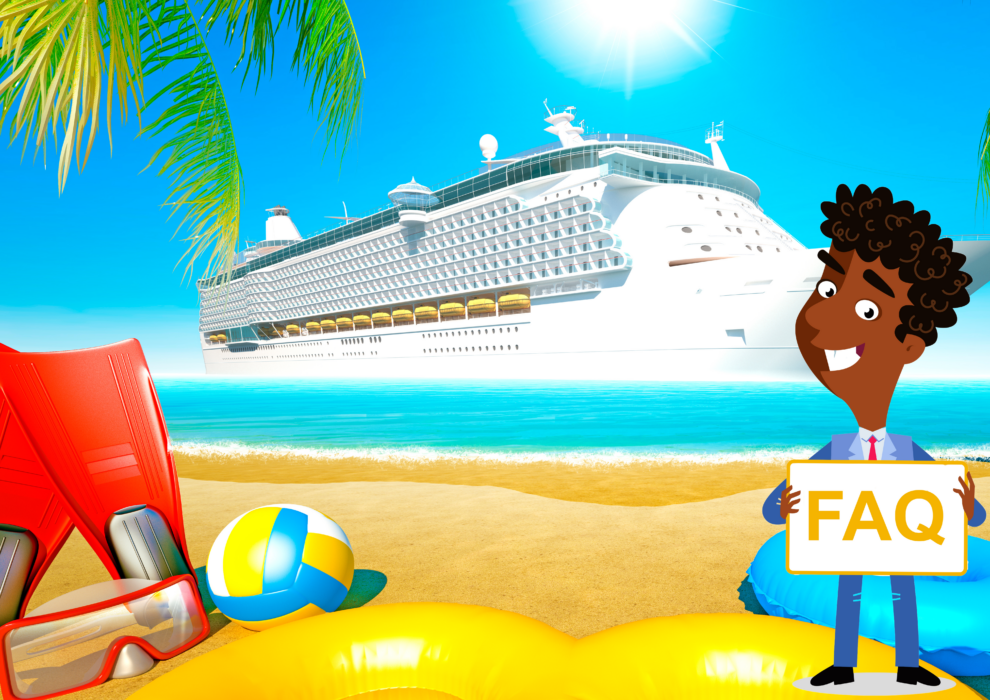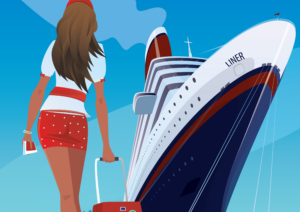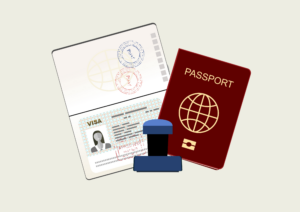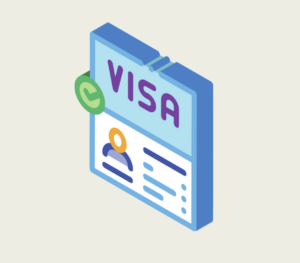FAQs

Cruising is a great way to see the world while relaxing at the same time. Some of you may have questions about cruising, which hopefully we’ve covered below. We’ll discuss when to arrive at the port, what is involved with embarkation and disembarkation, recommended cruise attire, how to pay for items while onboard, how to access wi-fi, alcohol and more! So, if you’re wondering what cruising is all about, keep reading for the answers!

All cruise lines operate a cashless system onboard, with few exceptions. Most cruise lines will require you to open a cruise account when you first board the ship. For this, you will need to register your credit or debit card against your cabin number. Sometimes, you can register in advance via the cruise line’s website or app.
When you arrive at the cruise terminal, your picture will be taken, and you will be issued with your cruise ID card. This ID card will serve as your room key and your charge card for all purchases on board the ship, such as spa treatments, gifts, specialty dining, shore excursions and drinks. Be mindful of your ID card, as you will need it to get on and off the ship at ports of call! If you set a limit of spending on your card, some cruise lines will allow you to top up money on your onboard account using cash or a card.
Before you board your ship, some cruise lines also offer the option to pre-purchase credits that can be used throughout your cruise. This is what is known as Onboard Credit. Each cruise line is different, but the most common ways you can check your onboard account balance are on the TV in your cabin, on the cruise line’s app on your phone or at the reception desk, where you may be able to obtain a printout of your onboard spending.
Now to the exceptions. On most ships, you can settle your onboard account with cash. You can use cash in the casinos, any payouts made to you will also be made in cash. Should you wish to leave a tip for your cabin attendant or any crew member, although not mandatory, cash will always be welcomed. Gratuities (tips), unless otherwise specified, will be added automatically to your onboard account.
Tip – Cash is always king when shopping at port stops, so remember to buy some foreign currency before you depart. Exchange rates will always be more favourable in your home country than at a foreign port of call.

Many people make the mistake of thinking that they need to depart for their cruise on the same day that the cruise gets underway. In reality, it is best to depart for your cruise one day or more before your cruise sets sail, even if it departs in the evening. This way, you’ll have a much better (and far less stressful) chance of making it to the cruise terminal on time. If your cruise departs from a port that requires you to take a long-haul flight or a long train journey, it is best to arrive two days in advance.
Tip – An early arrival will allow you time to get over your jet lag, explore your port location or simply just relax before your cruise sets sail.

Embarkation is the first day of your cruise holiday, the day you arrive at the cruise terminal to board the ship. The embarkation process can vary depending on the cruise line and the cruise port, but it typically involves dropping off your luggage, going through security, and proceeding to a check-in station. It is at the check-in station where you will present the required documents, have your photo taken and will be given your cruise ID card.
Tip – Pay special attention to precisely when embarkation check-in ends. In most cases, check-in ends before the ship departs on its journey, and you wouldn’t be able to board the ship even if it is still in port. This is somewhat similar to the way airlines operate.
Disembarkation is the last day of your cruise holiday when you leave the ship. This procedure is much simpler, you pack up your belongings and leave the ship as directed. Instructions for what time to disembark, your colour-coded labels and luggage collection points will be left in your cabin 24 hours before the ship docks. The crew will collect your luggage and take it to the luggage hold area, where it will be kept until you collect it from the cruise port terminal in the baggage reclaim area.
As a rule, you will be asked to disembark the ship before 8:00 am, so plan to have an early breakfast on the last day of your cruise. There is always a quick turn-around on the last day, as the crew will need to prepare the ship and the cabins for the next sailing, which will commence within hours.
Tip – You can carry your own luggage off the ship without the assistance of the ship’s crew or porters. This is a quicker way to exit the ship. However, if you opt for collection, your luggage must be tagged with the colour-coded label provided and placed outside your cabin door within the instructed timeframe.

It depends on the type of cruise you’ve booked, as there is no one-size-fits-all. Much of it depends on the type of cruise you’re going on as well as the destinations you will be visiting. However, there are a few essentials that every cruiser should pack, regardless of their itinerary. These items include comfortable walking shoes, casual clothing, swimwear, sunscreen and sunglasses. Many of the cruise lines will have a formal night or two where passengers are encouraged to dress up in their best evening wear. Outside of formal nights, casual clothing is typically acceptable during the day. You may, however, want to pack nicer clothes for dinner and other activities in the evening, such as themed nights.
Tip – The most important thing to remember is that on arrival at the cruise port, your luggage will be taken from you by a porter employed by the ship. The next time you see your luggage, it will be outside your cabin door. Sometimes the process of transporting luggage to your cabin takes a little while, which is why it’s best to plan ahead since you may not have access to your luggage for the first few hours of your cruise. As your carry-on luggage will remain with you, we advise that you pack anything that you might need for those few hours in that bag. In your carry-on, you may want to pack items such as your medication, phone chargers, or a change of clothes.

Don’t assume that you can’t, sometimes you can. There are many cruise lines that allow each adult passenger to bring a limited amount of alcohol on board the ship. This is usually restricted to a bottle of wine or champagne only. You may be charged a corkage fee if you choose to drink your own alcohol in the ship’s restaurants or bars. If you are permitted to bring alcohol onboard, be transparent. All luggage is scanned for alcohol, drugs and dangerous objects, so it’s highly likely that the alcohol will be discovered.
Whether or not you are allowed to bring your own alcohol onboard, all cruise lines offer a drinks package that can be purchased. Sometimes, you may be fortunate enough to have a drinks package as part of your cruise booking. Should you purchase any alcohol from one of the ports you visit during your cruise, it will be taken, tagged and stored in a safe location and returned to you the day before you disembark.
Tip – It is important to check the cruise line’s policies before packing any alcohol, as some lines have stricter rules than others. In any event, we at All Aboard will be available to help.

We completely get it. You’re excited to share your cruise experience with your family and friends. You take out your phone, start to select some photos to share, and are about to press send. Then you look around, and you realise… you’re in the middle of the ocean. What to do? Well, that depends. If you’ve purchased the cruise line’s internet package or if you have an internet package as part of your booking, you can log onto the ship’s WiFi and share away! But, if you have not purchased a WiFI package, our advice would be to turn your phone’s aeroplane mode on, relax and enjoy your cruise and wait till you return home to share your lovely images. Should you forget this vital step, the horror of returning home to a massive phone bill will always dampen your happy cruise memories. Why would your phone bill be so high? Well, as you would most likely be cruising in international waters, maritime rates will apply, and they are steep!
Tip – It’s best to check with your mobile phone provider if they offer any special rates for the country/countries you will cruise to, but note this may not cover you while at sea. If you are like a lot of us and believe you will need internet access at all times, explore your cruise ship’s internet options for peace of mind.

Shore excursions are optional activities offered at the ports of call you will visit during your cruise holiday. You can book a shore excursion in advance or when you are onboard the ship (depending on availability). Shore excursions involve exploring the local area through guided tours and experiencing all that the port-of-call has to offer. Shore excursions can suit almost every cruise personality – the cultural connoisseur, the thrill seeker and even the foodie. Shore excursions can be arranged as a private tour, thereby allowing you to customise the excursion to better suit you and your party. Or, you can book yourself onto an existing tour, meeting other cruisers along the way!
Tip – To avoid disappointment and to better plan your time at the port-of-call, it’s best to research your shore excursion options before you set sail. The best and most popular excursions will always sell out first!

Specialty dining on a cruise ship refers to the more upscale dining options available onboard. These for-fee restaurants offer cruisers an enhanced dining experience with a more refined menu and atmosphere than the complimentary dining restaurants. Whilst most specialty dining options charge a flat fee for entry and are open for dinner, some are also open for lunch and charge fees based upon each dish ordered. Some cruise lines will offer themed specialty restaurants, such as a sushi bar or a steakhouse, that can serve aged and hand-cut, cooked-to-order steaks and premium seafood.
Tip – Specialty restaurants are a great place for cruisers to celebrate a special occasion, such as a birthday or an anniversary.

Yes, you will need a valid passport, biometric or machine-readable, with a minimum of 6 months validity after your disembarkation date. Please also ensure that your passport has enough blank pages for entry and exit stamps for the ports of call on your itinerary.

Like air travel, at times, a valid visa is required before entry into a country. It is important to note that even if you do not plan to disembark at one of the ports of call, you are still required to obtain a valid visa for all the ports that your cruise will visit. There are a few countries where the visa requirements are handled by the cruise line. If this is not the case, it will be your sole responsibility to obtain and have available the proper travel documents that are necessary for your cruise holiday.
Tip – You should also allow enough time for the processing of any required visa(s) and renewal of your passport. Boarding may be denied if you arrive at the cruise terminal at the beginning of your cruise holiday without the proper travel documents. For such an error, no refund will be offered.
